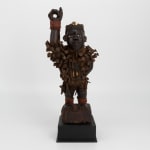Nkisi Power Figure, Early 20th Century CE
Wood, nails and glass
height 31.5 cm
height 12 3/8 in
height 12 3/8 in
ES.8683
Further images
This impactive magicio-religious piece is one of the most ubiquitous icons of African art – the so-called “nail fetish” (nkisi nkondi), arguably the Kongo Kingdom’s greatest artistic achievement. Conceived to...
This impactive magicio-religious piece is one of the most ubiquitous icons of African art – the so-called “nail fetish” (nkisi nkondi), arguably the Kongo Kingdom’s greatest artistic achievement. Conceived to house specific mystical forces, they were collaborative creations of sculptors and ritual practitioners.
The main focus of the piece is the prominent object attached to the figure’s abdomen. This addition is made from magical items – such as grave earth from the grave of an important person, blood and other organic material – that were affixed as a lump to the figure, thus endowing it with power. Sometimes substituted or combined with magical materials such as glass or mirrors, the “bilongo” was the most significant part of these figures, which were appealed to for supernatural help in times of adversity. The piece, however dramatic, was of secondary importance to the bilongo.
In order to appeal for supernatural help against an enemy, one would hammer a nail into or otherwise abuse (setting off explosions in front of him, for example) the statue, the spirit of which would become enraged and go to punish the miscreant. The attention of the spirit was sometimes guided by “dogs” – small bundles of textile and other materials that were attached to the nail and that were relevant to the request (the hair from a stolen goat, for instance). The spirit would thus know whom to punish, and if the applicant made his “prayer” known to the village, the miscreant might develop psychosomatic symptoms or otherwise betray him/herself in fear of what might happen.
The Kongo (or Bakongo) people live in the Democratic Republic of the Congo, Angola and the Congo. The kingdom absorbed European traditions and religion without excessive bloodshed, and, more importantly, with much of their indigenous culture intact. Indigenous Kongo society was based around the kingship model, with extensive arrays of civil servants and court officials not unlike that of the Nigerian Kingdom of Benin. Their religious beliefs are based on a reverence for the dead who are believed to be able to assist in the determination of future destinies. They are also believed to inhabit minkisi (singular nkisi), or charms, that can be appealed to for assistance in times of duress or uncertainty. The most notable pieces of Kongo sculpture are the Nkisi Nkondi figures, as detailed above.
This is a socially and aesthetically important piece of African art and a credit to any serious collection of the genre.
The main focus of the piece is the prominent object attached to the figure’s abdomen. This addition is made from magical items – such as grave earth from the grave of an important person, blood and other organic material – that were affixed as a lump to the figure, thus endowing it with power. Sometimes substituted or combined with magical materials such as glass or mirrors, the “bilongo” was the most significant part of these figures, which were appealed to for supernatural help in times of adversity. The piece, however dramatic, was of secondary importance to the bilongo.
In order to appeal for supernatural help against an enemy, one would hammer a nail into or otherwise abuse (setting off explosions in front of him, for example) the statue, the spirit of which would become enraged and go to punish the miscreant. The attention of the spirit was sometimes guided by “dogs” – small bundles of textile and other materials that were attached to the nail and that were relevant to the request (the hair from a stolen goat, for instance). The spirit would thus know whom to punish, and if the applicant made his “prayer” known to the village, the miscreant might develop psychosomatic symptoms or otherwise betray him/herself in fear of what might happen.
The Kongo (or Bakongo) people live in the Democratic Republic of the Congo, Angola and the Congo. The kingdom absorbed European traditions and religion without excessive bloodshed, and, more importantly, with much of their indigenous culture intact. Indigenous Kongo society was based around the kingship model, with extensive arrays of civil servants and court officials not unlike that of the Nigerian Kingdom of Benin. Their religious beliefs are based on a reverence for the dead who are believed to be able to assist in the determination of future destinies. They are also believed to inhabit minkisi (singular nkisi), or charms, that can be appealed to for assistance in times of duress or uncertainty. The most notable pieces of Kongo sculpture are the Nkisi Nkondi figures, as detailed above.
This is a socially and aesthetically important piece of African art and a credit to any serious collection of the genre.











